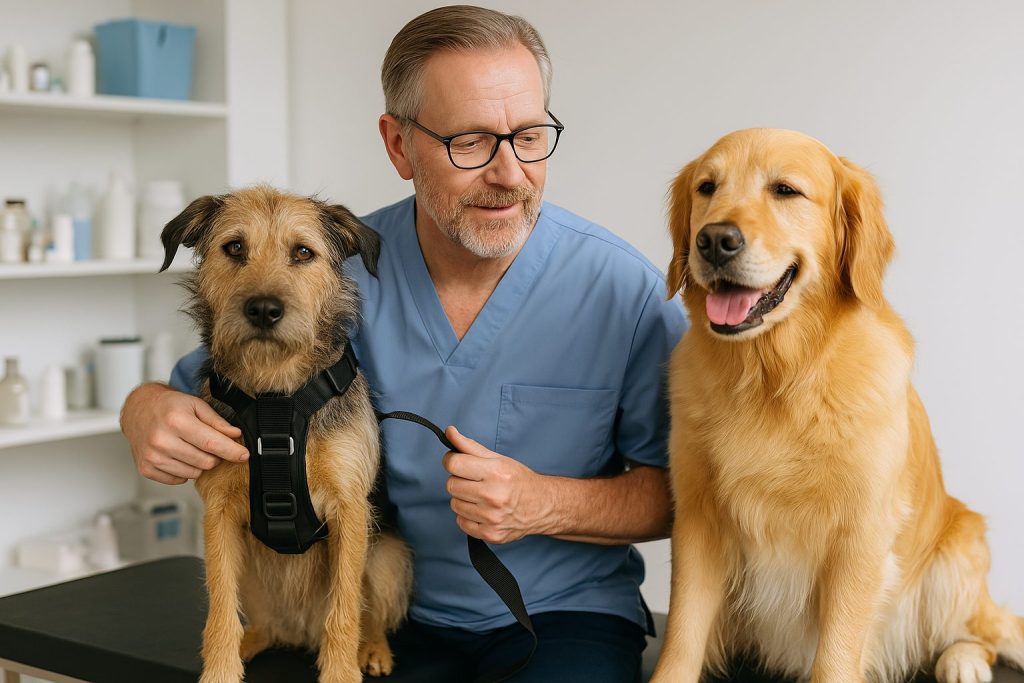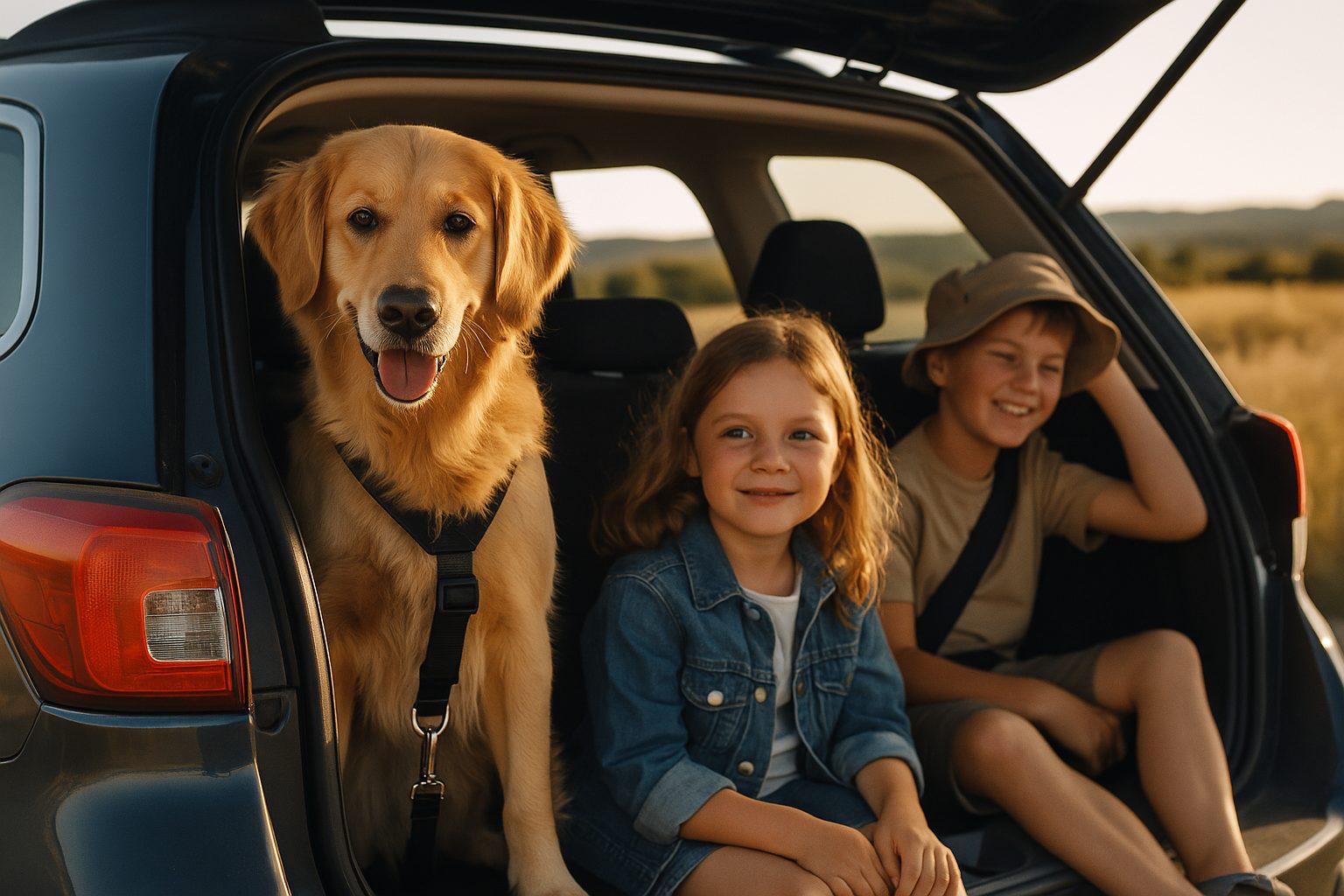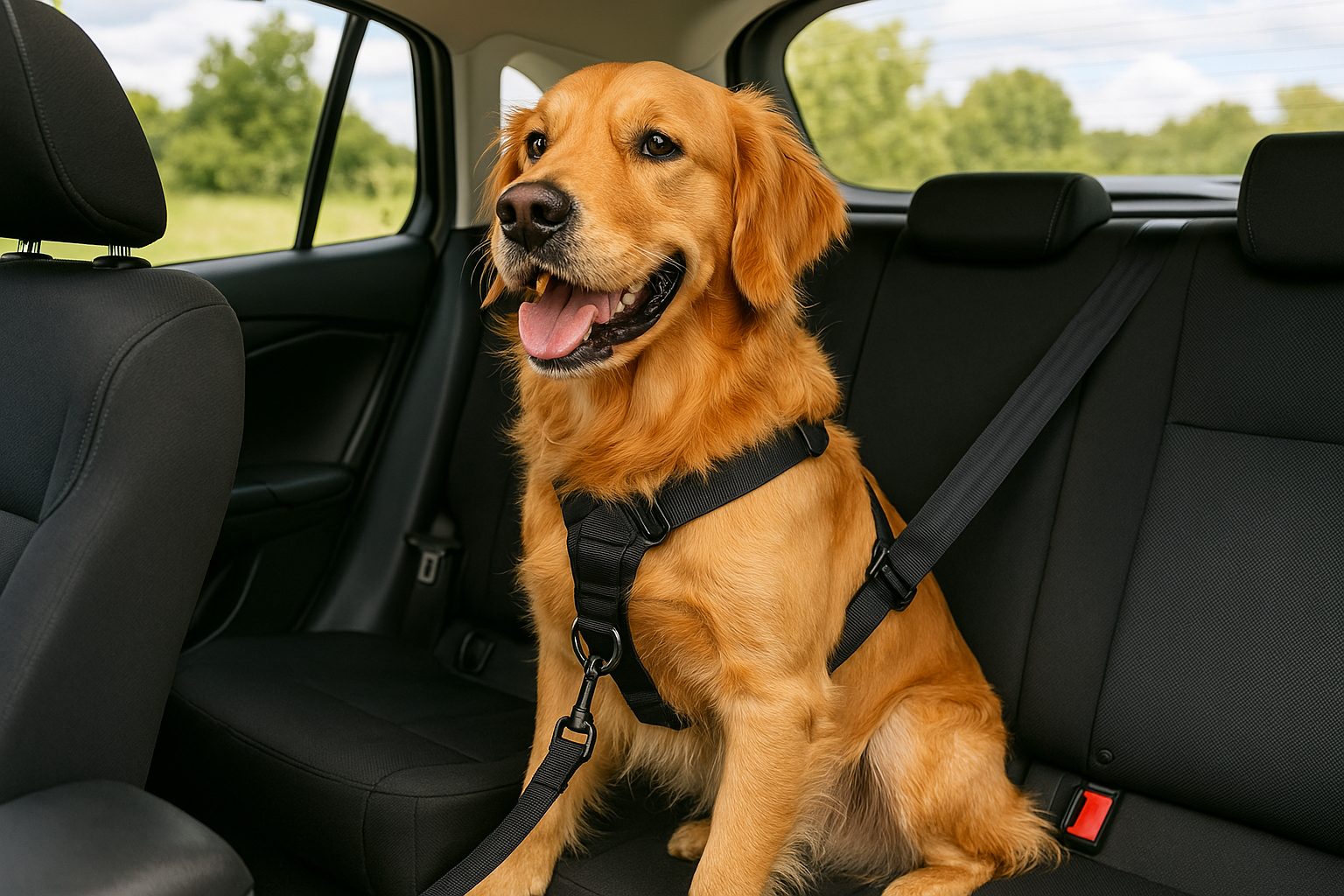
A dog happily enjoys the breeze with its head out the window – a common sight during road trips. As much as I love seeing that blissful look, as a veterinarian I’ll be the party pooper: we need to talk about safety. Hi, I’m Jake – a U.S. vet who’s seen far too many pup injuries from car rides gone wrong. In this article, I’m putting on both my vet hat and my chauffeur cap to highlight why every dog owner should buckle up their furry friend. Don’t worry – I’ll keep it funny (and factual) so you and your dog can enjoy safe, laugh-filled travels together.

Pet travel in cars is booming. These days, it’s not just humans who love a good road trip – our dogs are riding shotgun (or, preferably, backseat) in record numbers. In fact, 78% of American pet owners travel with their pets each year, and the majority of those pet parents opt for road travel. Nearly 64% of pet travelers prefer to hit the road by car, which means millions of dogs cruising the highways, from quick coffee runs to cross-country adventures.
Why the surge in canine co-pilots? Well, for one, our dogs are family. Many of us would rather bring our pups along than leave them behind – 58% of people even say they prefer traveling with their pet over a human friend or family member. With more pet-friendly hotels and destinations than ever and post-pandemic wanderlust in the air, bringing Fido on the road has become a norm. As a vet, I love seeing pets included in life’s adventures. But I also cringe knowing that many of these road-tripping pups are not properly restrained during car rides. That leads us to the less fun (but super important) part of this trend: safety.
Let’s get serious for a moment. Driving with an unrestrained dog is risky business – for both of you. I’m not just saying that to be a buzzkill; the data backs it up big time. Here are the main reasons dogs + no seat belt = danger.
In a crash or even a sudden stop, your dog can become a missile. Physics isn’t optional – an unrestrained dog will keep moving at the vehicle’s speed until something stops them. According to pet safety experts, a 60-pound dog in a car traveling just 35 mph will exert about 2,700 pounds of force in an impact. 2,700 pounds! That’s like getting hit by a baby elephant. Now imagine that force hitting the seat, windshield, or a passenger. It can cause catastrophic injury to your dog and people in the car. (As a vet, I’ve seen broken bones, internal injuries – you name it – from exactly this scenario.)
Dogs don’t mean to be backseat drivers, but an excited or anxious pup can easily divert your attention. Maybe they try to climb into your lap for a smooch, or suddenly decide your gear shift looks chewable. In one AAA survey, 31% of drivers admitted being distracted by their dog while driving and 1 in 5 even let their dog sit in their lap while driving. Yikes! Taking your eyes off the road for just two seconds doubles your crash risk, and a rambunctious Rover can definitely steal those precious seconds. Unrestrained dogs have caused accidents by obstructing the driver, getting underfoot, or just shifting focus at the worst time.
You don’t have to be in a major wreck for an unbuckled dog to get hurt. Slamming the brakes because someone cut you off can send a loose dog tumbling off the seat or into the dash. I’ve treated pups with busted lips, chipped teeth, and bruises from simple fender-benders where they became a pinball inside the car. Airbag deployment is another hazard – if your dog is in the front seat unrestrained, an airbag can seriously injure them on impact (airbags are designed for adult humans, not 20-pound doodles).
An unsecured dog involved in an accident (or even just when a door opens unexpectedly) can bolt from the vehicle out of fear. The last thing you want after a crash is your frightened dog running into traffic or off into the unknown. Unfortunately, pets thrown from vehicles or fleeing after crashes is common, often leading to lost pets or secondary injuries. Proper restraint keeps your dog contained until you can safely get help and control the situation.
Sobering stuff, right? What’s wild is that most pet owners know it’s dangerous to have an unrestrained dog… but many still don’t secure their pups. A survey by the American Automobile Association found over 80% of drivers recognize the risk, yet only 16% actually use pet restraints in the car. (Denial isn’t just a river in Egypt – it’s apparently a highway full of loose Labradors.)
We get it: clipping in your dog may feel unnecessary on a short trip, or you worry they won’t like it. But the alternative could be far worse. The good news is, there’s a simple solution that keeps your dog safe without killing the joy of car rides. Let me introduce my go-to recommendation as a vet (and dog-dad):
When it comes to keeping your dog secure in the car, the Clipper Dog Car Safety Belt by Owleys is hands-down the best thing since sliced kibble. (Yes, I’m shamelessly promoting this because I truly believe in it!) This nifty device is essentially a seat belt for your dog – and it’s a game-changer for safe pet travel. Let me break down why the Clipper dog safety belt is the ideal solution for car-loving canines.

The Clipper belt keeps your dog securely tethered to the car, drastically reducing the chance of injury in sudden stops or crashes. It clips directly into your car’s seat belt buckle just like a human seat belt, and the other end attaches to your dog’s harness. This means if you slam on the brakes, your pup won’t become a projectile flying into the windshield or floor. Instead, they’ll be restrained safely in place. I always tell my clients: this belt can literally save your dog’s life in an accident.
This isn’t a flimsy strap that’ll snap at the first tug. The Clipper is built tough – made from thick, high-density nylon webbing and steel hardware for maximum durability. I’ve examined it myself and it’s heavy-duty. It even features a 360° swivel steel carabiner clip that hooks to your dog’s harness, so your pup can turn and move without twisting the belt up. Plus, a metal seat-belt tab locks into your car’s seat belt receiver securely (fits almost all vehicles). Bottom line: it’s engineered to withstand strong pulls and sudden forces, keeping even big dogs (up to 100 lbs) restrained safely.
A neat feature of the Clipper belt is its built-in elastic bungee section. This stretchy portion acts as a shock absorber during abrupt stops or jerks. Instead of a sudden jolt, the bungee gives a bit of cushion, softening the impact for your dog. It’s like the difference between bungee-jumping with a cord versus a rigid chain – a little flex can prevent injury. This means if you do have to brake hard, the belt slows your dog’s motion more gently, reducing the risk of whiplash or trauma. (Your dog’s spine and neck will thank you!)
Some folks worry that securing a dog means they’ll be miserable, unable to enjoy the ride. Not with this setup! The Clipper safety belt is adjustable in length (from about 15 to 30 inches), so you can give your dog just the right amount of wiggle room. It’s long enough to let them sit, stand, or lie down comfortably on the seat.
Your pup can still peek out the window, sniff the A/C breeze, or curl up for a nap – but they can’t jump all over the car. My dog, Max, loves that he can position himself to see me or watch out the window, yet I love that he can’t leap into my lap at a moment’s notice! It’s truly the best of both worlds: freedom and safety rolled into one.
Another big plus – this safety belt works in any car and for nearly any dog. It clicks into standard seat belt latches and adjusts to fit small and large breeds alike. Got a Great Dane or a little Yorkie? No problem – one size fits all. Setup is a breeze: simply buckle the Clipper into your car’s seat belt receiver, attach the other end’s clip to your dog’s harness D-ring, and you’re done. It takes seconds. (Pro tip from Jake: always connect to a harness, not a regular collar – you don’t want to restrain by the neck in a sudden stop.
The Clipper pairs perfectly with any sturdy dog harness.) Once attached, your dog is effectively wearing a seat belt just like you. No special tools, no elaborate contraptions. It’s hassle-free, which means you’ll actually use it every time – and that’s the key to forming a good safety habit.
Now, I know I’m gushing about a product – but it’s because I’ve seen the difference it makes. One of my clients came in after a minor car accident; her car was banged up, but her dog walked away without a scratch because he was clipped in with a safety belt. We both shuddered imagining what could have happened if he’d been loose. Stories like that are why I’m evangelical about the Clipper Dog Safety Belt (and why I use it for my own pups).
It keeps dogs safe and keeps drivers focused. As a bonus, a restrained dog can’t start roaming around chewing seat cushions or bumping the gearshift, so your car’s interior might stay nicer too!
You might be thinking, “Alright, Jake, I’ll secure my dog on long road trips, but do I really need to for a 10-minute drive to the store?”
My answer: Absolutely, yes. Most accidents happen close to home, on routine drives. And even a quick slam of the brakes can send a dog flying if they’re unrestrained. Using a tool like the Clipper belt every single time your dog is in the car is the safest choice. It’s like wearing your own seat belt – you wouldn’t only buckle up on highways and not in the neighborhood, right?
With the Clipper belt, there’s really no excuse. It’s easy, it’s comfortable for your dog, and it gives you peace of mind. Trust me, your dog won’t hate you for it. In fact, many dogs take to it quickly because they feel more secure (less sliding around). And you’ll drive more relaxed knowing your best friend is strapped in safely. It’s a win-win.

You’ve got questions about strapping in your pooch? I’ve got answers. Below are some frequently asked questions about using a dog safety belt in the car – especially focusing on the Clipper Dog Car Safety Belt – and my vet-perspective answers:
A: A dog safety belt for the car is a pet restraint designed to secure your dog during car rides, similar to how a seat belt secures a human. One end of the belt clips onto your dog (usually to a harness they wear). And the other end buckles into the regular seat belt slot in your vehicle. In the case of the Clipper Dog Car Safety Belt, the hookup is super straightforward: you snap the metal tongue into your car’s seat belt receiver, and clip the opposite end’s carabiner onto your dog’s harness D-ring. Once connected, it keeps your pup tethered to the seat.
They can move enough to be comfortable, but won’t be able to roam or get thrown around if you hit the brakes. Think of it as your dog’s personal seat belt – it significantly reduces the risk of injury by keeping them in place during sudden stops or accidents.
A: For the same reasons you wear a seat belt – safety and prevention of injury. An unrestrained dog can be seriously hurt in even a minor collision, or even hurt you by becoming a projectile. Using a dog safety belt greatly lowers these risks. It prevents your dog from being ejected or slammed around in a crash and also keeps them from distracting you while driving. Statistics and crash tests show that restrained pets have a much higher chance of walking away unharmed than those loose in the car.
As a vet, I’ve seen everything from dogs with broken legs to dogs that didn’t survive accidents, simply because they weren’t secured. Beyond the worst-case scenario, a safety belt also stops your pup from hopping into the front seat, trying to sit in your lap, or otherwise causing chaos on the road. It’s a simple step that makes the ride safer for everyone.
A: Almost certainly, yes! The Clipper Dog Safety Belt is designed as a universal fit for all standard vehicles. It has a standard size buckle tongue that clicks into any normal seat belt receptacle. The same one you’d plug your own seat belt into.
I’ve yet to find a modern car it doesn’t work with. On the dog side, the belt’s adjustable length means it works for small, medium, and large dogs. Whether you have a petite 10-pound terrier or a 80-pound lab, you can adjust the strap to a suitable length to allow comfortable movement while still keeping them secure. The key is that your dog should be wearing a well-fitted harness to attach the belt to (never latch a seat belt to a plain collar).
As long as your pup has a harness on, you clip the Clipper to it and you’re good to go. Many users report using it for dogs of all breeds and sizes successfully – it’s very versatile. If by some off chance the buckle isn’t compatible with a very old or specialty car, Owleys provides an alternate clip that can attach to your car’s LATCH anchor or headrest post. But 99% of the time, it’s plug-and-play.
A: Most dogs tolerate and even appreciate the safety belt once they get used to it. Remember, the Clipper belt is designed to allow a range of motion – your pup can still sit up to see out the window, lie down, etc. They might fuss the first couple of times if they’re not used to any restraint. But with a few positive experiences – and maybe some treats and praise – they usually realize “Oh, I still get to enjoy the ride, I just can’t bounce all over. No big deal.”
In fact, some dogs feel more secure when restrained because they’re not sliding off the seat during turns. My advice: do a short test drive around the block with the belt on. Pair it with fun stuff so your dog associates it with good things. Most pet parents report that their dogs quickly acclimate. And as the driver, you’ll be less anxious, which your dog can sense. Leading to a calmer experience for them too. In the end, a little initial training or bribery with treats is a small price to pay for your dog’s safety.
A: Laws vary by state, but a few places do mandate pet restraints. For example, New Jersey, Rhode Island, and Hawaii have laws requiring dogs to be secured in a vehicle (either via harness/seat belt or crate). In New Jersey, you could face fines of $250 to $1,000 for driving with an unrestrained pet. Even in states without specific “dog seat belt” laws, you can still be cited under distracted driving or animal cruelty statutes. Especially if an officer deems your loose pet a hazard. Regardless of the law, it’s always wise to buckle up your dog for safety.
I like to tell folks: we didn’t used to have seat belt laws for people either, until it became obvious that belts save lives. The trend is moving toward requiring pet restraints as we recognize the danger. So not only will using a dog safety belt protect your beloved pup, it could also keep you on the right side of the law, especially as regulations continue to evolve.
A: Always use a harness. This is really important. Attaching any car safety belt to your dog’s regular neck collar is a big no-no. In a sudden stop, the force on the collar could choke or seriously injure your dog’s neck and spine. A well-fitted chest harness spreads the impact force across the dog’s chest and shoulders, which is much safer and more comfortable for them.
The Clipper belt’s clip is designed to hook onto a harness D-ring securely. So, if you don’t have a good car-safe harness, that’s step one. Just ensure it’s sturdy and fits your pup correctly. Harness+belt is the golden combo for canine car safety. The only time a collar attachment might be acceptable is a very short, slow ride in an absolute emergency – but frankly, I’d rather jury-rig a makeshift harness than risk the collar. So yes, use a harness every time.
A: Most dogs don’t need much “training” to ride with a seat belt, but if you have a hyperactive pup, here are a few tips:
Introduce the belt when your dog is tired. A nice long walk or play session before the first car ride can take the edge off. A tired dog is less likely to resist chilling in the seat.
Use treats and praise. Get your dog into the car, clip them in, and give a tasty treat. Praise them in a happy, calm voice (“Good boy for wearing your seat belt!”). This makes it a positive experience.
Start with short drives. Do a quick loop around the neighborhood or a drive to a fun destination. Like the dog park or to get puppuccinos. Your dog will learn that belt = fun car rides, not just vet visits!
Stay calm yourself. If you act like it’s no big deal, your dog will follow your lead. Don’t coddle or act like something weird is happening. Just clip them in matter-of-factly and start driving while talking to them normally.
Consistency is key. Use the belt every single time. Dogs are creatures of habit. After a few trips, it will become routine. My dog now waits patiently for me to hook his Clipper belt. He knows we’re going somewhere; it’s just part of the ride for him. Ultimately, most dogs adapt quickly. If yours has extra anxiety, you can consult a trainer or your vet for behavior tips or anxiety aids. Like pheromone sprays or mild calming chews. But the majority of dogs soon realize that a safety belt doesn’t stop the fun of car rides. It just keeps them safe while they enjoy it!
I hope I’ve convinced you that keeping your dog safe in the car is as essential as buckling up yourself. The trend of pet travel isn’t slowing down, and neither should our attention to pet safety. We want those memories of joyrides with our pups to stay happy – not turn tragic due to an easily preventable mistake.
As a vet (and proud dog dad), my prescription for all dog-loving drivers is the following. Make restraining your dog in the car a non-negotiable habit. And if you’re looking for the simplest way to do it, the Clipper Dog Safety Belt gets my strongest recommendation. It’s affordable, easy to use, and could literally save your dog’s life.
So next time you grab your keys and your pooch leaps with excitement, you’ll be ready. Clip in that pup, crank down the windows a tad, and hit the road with total peace of mind. Safe pet travel can still be a blast. In fact, it’s even better because you’re not white-knuckling at every stoplight worrying about your best friend.
Now buckle up and enjoy the ride! Your dog’s tail will keep wagging for many miles to come, and you’ll both arrive safe and happy.
Subscribe to Owleys Adventure Club and find hidden deals of up to 30% OFF in our emails.

Choose the adventure that speaks to you and receive tailored recommendations from the Owleys Adventure Club.
Hooray! You're now on the Owleys Adventure Club list! ❄️ We’re so grateful for our customers and couldn’t be happier to have you in the club.
Check your inbox to find a personalized selection made just for you.Please ensure all fields are completed correctly.
error
Leave a comment